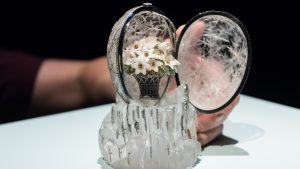The truth behind the most prevalent Thanksgiving myths

Every year, the Thanksgiving holiday brings together families, loved ones and a cornucopia of holiday myths often repeated at the dinner table. However, many of these commonly repeated stories are just that — stories.
From how it began to what’s served at the table, Straight Arrow News took a look at the most common myths and broke down how they started.
No, they didn’t sit at a table at the first Thanksgiving
When most people think of the first Thanksgiving dinner, they envision pilgrims and Native Americans sitting across from each other at a big table. Well, that never happened — and they didn’t eat pumpkin pie either.
Before 1621, the English pilgrims and the Wampanoag natives had known each other and had entered into a defensive pact against other native groups. The settlers benefited immensely from the alliance since the Wampanoag also taught them to fish, plant crops and collect shellfish.
Most historians agree that in 1621, the pilgrims held an event to celebrate their first harvest. It was a three-day feast where they ate common foods of the time, such as venison, waterfowl, corn, squash and possibly shellfish.
During the event, the settlers began shooting their guns to celebrate. Massasoit, the Wampanoag’s chief, collected a group of tribesmen and rushed to the colony, thinking it was an emergency signal. However, when they arrived, they found everyone was celebrating. So, the chief and the group he rallied joined in.
Historians say they didn’t eat at a big table garnished with nice silverware and tableware. Instead, they likely sat on the ground and ate with their hands since there wouldn’t have been many tables and chairs.
According to Live Science, the celebration wasn’t unique to the groups either. Textual evidence shows that the pilgrims and the Wampanoag had multiple harvest celebrations.
Thanksgiving wasn’t always on the 4th Thursday in November
While Americans now get the fourth Thursday in November off, the holiday wasn’t always celebrated on that day. America didn’t settle on that date until Congress established it in 1941.
Before then, several had made proclamations designating a specific day.
In 1789, President George Washington designated Thursday, Nov. 26, as a national day of “public thanksgiving and prayer” in his Thanksgiving Proclamation. This marked the first time a president proclaimed a national day of thanks.
However, not everyone followed Washington’s footsteps, and subsequent presidents didn’t recognize the holiday.
Then, in 1863, President Abraham Lincoln used Washington’s proclamation as a blueprint for his own. On the same day Washington made his proclamation, Lincoln recognized the last Thursday of November as “a day of Thanksgiving and Praise to our beneficent Father who dwelleth in the Heavens.”
Since the country was at war, southern states in the Confederacy celebrated the holiday on different days. However, many viewed the event as a “Yankee holiday,” since it originated in the North, and according to some at the time, it aligned with the abolitionist movement.
Since 1941, Americans have celebrated the holiday on the fourth Thursday of November.
Yes, you can reheat leftovers multiple times
Much like the changing dates, what’s on the dinner table has also changed throughout the years. What is now the main centerpiece, turkey, wasn’t included on the dinner table until at least the 1800s.
While some may think serving ham is a modern alternative to serving a turkey, ham was actually common before turkey became the main dish. Throughout the 1800s, some regions of the country served ham because pigs were cheaper to raise.
Many people think cranberry sauce was one of the dishes served at the first Thanksgiving, but that’s not true. Cranberries are native to North America, but it wasn’t until 1672 that cranberry sauce was first mentioned.
During that time, settlers would boil cranberries and sugar to make a sauce to serve with meat. The first documented account of cranberry sauce wasn’t until 1796 in a cookbook called “American Cookery.”
Speaking about cooking, another myth is that stuffing and dressing are the same thing. While they are made with the same ingredients, the way they’re prepared changes what they are.
Dressing is cooked outside the turkey, while stuffing is, well, stuffed and cooked in the bird. Despite the difference, most people use the words interchangeably.
No matter if someone cooks a dish inside or outside the bird, it will have to be reheated. The good news is that reheating leftovers multiple times is totally safe.
A common myth is that once food is reheated, it cannot be reheated again. In reality, as long as the food isn’t spoiled and reaches above 165 degrees, it’s safe to eat.
The most significant risk is letting food stay at room temperature too long. It’s also important to note that microwaving food can lower its quality, so only reheat what you plan to eat.
When you wish upon a bone
Once dinner is done, but the pies are still in the fridge, some families pull out the wishbone. While some say it’s an American tradition, it’s actually much older.
The tradition dates back to 800 B.C., with the Etruscans in modern-day Italy. They had a tradition with the wishbone, or furcula, of chickens. They would remove it, let it dry in the sun and then touch it to make a wish. Etruscans believed birds were oracles, and if someone touched their bones, they could have a better future.
Years later, the Romans began their own wishbone tradition, where they would fight over it. Whoever had the larger piece would have their wish fulfilled, according to Roman tradition.
They eventually passed the tradition on to the ancient Britons, who brought it to the New World, where it is still carried on to this day.
The post The truth behind the most prevalent Thanksgiving myths appeared first on Straight Arrow News.





